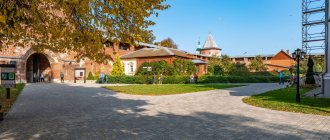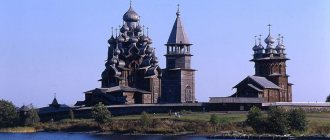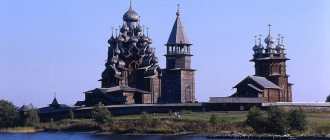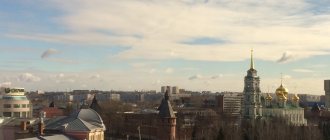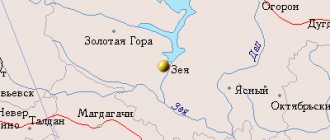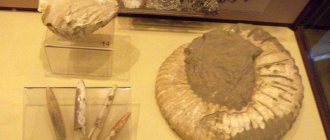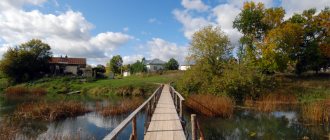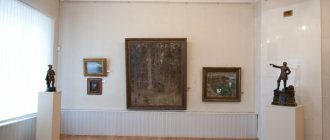370 km from Moscow and 80 km from Yaroslavl is the city of Rybinsk, which is the administrative center of the Rybinsk region. It is located in a picturesque place, at the confluence of the Volga, Cheryomukha and Sheksna rivers. In addition to them, the city crosses several other small rivers and streams.
A wonderful Russian city is located at the northern point of the Volga, until Rybinsk the great river carries its waters to the northeast, and from Rybinsk it turns to the southeast. The city is located on its two banks, but its main part is located on the right bank.
Sights of Rybinsk
The city has preserved quite a few architectural monuments (XVIII - XX centuries), which are of interest to historians and researchers, and are always visited by guests. The entire historical center was built in the 19th century, although many buildings were rebuilt several times. The main decoration of the city are the buildings of the grain exchange. They were built on the banks of the Volga.
The old exchange was made in a classical style, the new one was built in 1912. The building is designed in pseudo-Russian style. The author of the project was A.V. Ivanov. The outside of the magnificent structure is covered with tiled tiles. It stands on a massive stone plinth, which stretches along the Volga bank. Currently, the main attraction of the city is located here - the Rybinsk Historical, Architectural and Art Museum-Reserve.
The exchange building, the cathedral, and the bridge over the Volga are part of a single ensemble that has become the hallmark of this city. The Rybinsk Museum-Reserve is the largest and most visited in the region. It has a rich collection of cultural and historical exhibits.
Vaccination news
Rybinsk State Historical, Architectural and Art Museum-Reserve
The Rybinsk State Historical, Architectural and Art Museum-Reserve is one of the largest museums in the Upper Volga. The main exhibitions of the museum are located in the most beautiful building of the city, the former “new” grain exchange, erected in 1912 according to the design of the Moscow architect A.V. Ivanov in elegant forms of the “Russian style”. History of the museum: The museum was opened on October 17 (30), 1910. The initiators of its creation were members of the Rybinsk branch of the Yaroslavl Natural History Society. The first public exhibition included materials from the natural science collection of V.S. Mikhalkov (1817 – 1900), owner of the Petrovskoye estate. In 1927, the natural science museum was merged with the art and historical museum, which had existed since 1919, into the Rybinsk Museum of Local Lore. The basis of the museum collection was laid by the collections of nationalized surrounding estates: Petrovsky, Borisogleb and Ilovna, Sosnovets, Tikhvino-Nikolsky. In the 1920-1930s. they were supplemented by works of art from the capital's collections (a collection of folk art collected by an ethnographic expedition of the Russian Museum, a group of objects of foreign ceramics and porcelain from the collection of the State Hermitage), collections of the liquidated Myshkin, Poshekhon and Mologsky museums. Throughout its activities, the museum carries out extensive collecting work, bringing from expeditions, purchasing, and receiving exhibits from its numerous collections as gifts. By the end of the 1980s. new prospects for the development of the museum appeared and in 1988 it received the status of a historical, architectural and art museum-reserve. Collections and exhibitions The collection of the Rybinsk Museum is amazing and diverse. Currently, the collection numbers about 120 thousand exhibits and is very diverse. Russian and foreign paintings and graphics, including entire family portrait galleries. Furniture, weapons, porcelain, glass, bronze, where it is sometimes difficult to distinguish a household item from a work of art. The collection of icon painting, which includes local icons of the “Romanov letter”, a special direction from late Russian icon painting, is the pride of our collection. Archaeological finds and remains of fossil animals. The museum’s exhibitions tell about the history of the rich trading city, about Catherine the Great’s visit to it in 1767, about the work of barge haulers, whose “capital” was Rybinsk in the 19th century, about the life and work of its “celebrities” - merchants known throughout the Volga region, about the fate of prominent representatives of the nobility and their estates.
A special feature of the museum's art collection is its collection of foreign art - the largest in the region. It highlights sections of Western European graphics, painting, and applied art, including samples of products from leading European centers.
The exhibition of Russian art not only shows the works of famous masters of the 18th – early 20th centuries: I.Ya. Vishnyakov, I.K. Aivazovsky, I.I. Shishkin, Z.E. Serebryakova, N.K. Roerich, highlighted here in a separate section such a striking phenomenon of Russian culture as the “merchant portrait”. The portrait gallery of Counts Musin-Pushkin, in which works by F.S. Rokotov side by side with the creations of unknown serf talents. In the section of applied art of the 18th - 19th centuries. Gzhel majolica, porcelain dishes and figurines, glass damasks and goblets are presented.
In 1964, the Rybinsk Museum provided the Mosfilm film studio with about 50 of its exhibits (original furniture and accessories of the 19th century) for the filming of the famous film adaptation of L. N. Tolstoy’s novel “War and Peace” (1967, S. Bondarchuk).
Excursion programs for adults: “Both the fun and labors of the Lovetskaya Rybnaya Sloboda”, “Lost Atlantis or a date with Mologa”, “Rybinsk in the past”, “A trip through the art gallery”, - Sightseeing tour of the memorial house-museum of A.A. Ukhtomsky.
Excursion programs for children: “What the old town on the Volga remembers”, “To the museum for a fairy tale”, “Mologa - a fairy tale city, a city of reality”, “The childhood of Alyosha Ukhtomsky”, “Nature of the Rybinsk region”, “The peasant house is famous for its owner” .
Address: Volzhskaya embankment, 2 Tel: (4855) 222190
Memorial House-Museum of Academician A.A. Ukhtomsky
| The Memorial House-Museum of Academician Alexey Alekseevich Ukhtomsky was opened on September 20, 1990. The future scientist spent his childhood and adolescence in this house. The museum consists of five exhibition halls, which reflect all the main stages of the life of A. A. Ukhtomsky (1875-1942). The exposition of the House-Museum tells about the history of the ancient family of the Ukhtomsky princes. The interior of the living room was restored based on Alexey Ukhtomsky’s childhood memories. In one of the rooms, Ukhtomsky’s office at the Physiological Research Institute in St. Petersburg is recreated. The museum introduces the scientist’s scientific works, the principle of dominance, which anticipated the discovery of humanistic psychology, and developments in the field of social, moral, ethical and religious problems. Ukhtomsky's legacy places him among the greatest social thinkers of the 20th century. The house-museum is a scientific and methodological center for the development of the heritage of an outstanding fellow countryman. | |
Address: st. Ukhtomskogo, 45 phone: (4855) 26-24-96.
Museum of the Mologa region
| The Mologa Region Museum is the world's only museum of flooded territories and was opened in August 1995. The main exhibition is dedicated to the natural, cultural and historical heritage of the Mologo-Sheksninsky interfluve, which in the 30s. XX century was flooded as a result of the creation of the Rybinsk Reservoir. The history of the region is rich and varied. The area where the city of Mologa later appeared was first mentioned in the chronicle in 1149; here on the banks of the Sit River on March 4, 1238 the famous battle with the Tatar-Mongols took place. The Principality of Mologa has existed since the 14th century, and in the 15th century. - its capital city is famous for its largest fair. The pride of the Mologa land is also its lesser-known natives: cultural and educational figures, merchants and townspeople, simple workers of this fertile land. The theme of the rise and fall of the city of Mologa is reflected in the main exhibition of the museum. This small part of the Mologa region, filled with memorial things, tells the story of the centuries-old history of a small provincial town. The main task of the museum is to preserve the rich and diverse cultural and historical heritage, to open the long veil of silence about the tragedy of this region, to become a unifying center for specialists involved in the problems of a comprehensive study of the reservoir, primarily environmental ones. Among the spiritual and cultural centers of the Mologsky region: monasteries - Afanasyevsky and Yugsko-Dorofeevsky, churches, rich noble estates, incl. A.I. Musin-Pushkin - a famous statesman, collector and publisher of Russian antiquities, the discoverer of “The Tale of Igor’s Campaign”, A.V. Sukhovo-Kobylin - a writer-playwright, N.A. Morozov - a scientist-encyclopedist, as well as famous noble families - princes Volkonsky, Golitsyn, Kurakin and others. Address: Preobrazhensky lane, 6a phone: (4855)29-53-93 |
Palace of Culture "Volzhsky" exhibition "Soviet era"
| Excursion “Born in the USSR”: We invite you to take a small “knowledge of life” test and get acquainted with the “brands” of the Soviet period, drink tea in a Soviet canteen, watch Soviet films, and visit the office of a party worker. group: 20 people from 12 years old | |
| Excursion “Here the Rybinsk Sea began”: The exhibition “Soviet Era” invites you to travel back to the years of the creation of hydroelectric power stations on the Volga and Sheksna, the flooding of the Rybinsk Reservoir and the construction of the hydroelectric construction village. The program includes watching documentaries, drinking tea in a Soviet canteen, and visiting the office of a party worker. Having been here once, you will definitely want to return. group: 20 people from 12 years old Excursion “Let there always be sunshine”: Soviet toys, school supplies, items with Soviet symbols. The children will get acquainted with the rituals of the Octobrists and Pioneers, children's hobbies of that era, and will also learn the history of the construction of hydroelectric power stations and the flooding of the reservoir. In the old cinema hall you will watch Soviet cartoons. Each little guest of our excursion will be able to make their own souvenir as a keepsake. Red flag, badge or dove of peace. group of 30 people from 7 to 10 years Working hours: Wednesday, Thursday, Friday from 10.00 to 16.00 With a guide: upon prior request, ticket price is 60 rubles. Independent viewing: 30 rub. Contact information, (4855) 20-73-51 | |
Private Museum “Nobels and the Nobel Movement”
Located in the building of the former shelter of the Pokrovsko-Voznesensky Brotherhood. The collection includes items from the Branobel office in Rybinsk. The museum took part in the Rybinsk Tourism competition in the category “Best Excursion and Tourism Program” in 2007.
The private museum “Nobels and the Nobel Movement” in Rybinsk has been operating for 4 years. Several items that remember members of the famous family are kept here: a corporate safe, an office desk. There is also an exhibition dedicated to Nobel Prize laureates with Russian roots.
The museum and exhibition complex invites you to visit the exhibitions:
- Exhibition “Nobel Noble and in Love”. Exhibits, documents, and photographs of the exhibition reveal the secrets of the business and personal success of the Nobel family. moved from Sweden to permanent residence in Russia in 1837. This secret lies in the character of the “adopted children of Russia.” The love for life, for their favorite work, for the beautiful half of humanity made the Nobels rich and famous. The cost of a tour of the hall for adults is 60 rubles, for children – 40. Excursion services – from 200 rubles. The museum offers city guests who arrive by their own transport a tour of the Nobel sites. The cost of the excursion is 800 rubles.
- Exhibition "Rybinsk-Cinema-Hollywood". The history of domestic and world cinema through the prism of the history of Rybinsk and the region. Presenting the fate of two natives of the city in unique documents, photographs, and objects of art, the guide will tell a fascinating story about the role of natives of Russia in the founding and formation of the famous city of illusion and fairy tales - Hollywood. All the brightest stars of Hollywood will come to life in this story: Marilyn Monroe, who was a close friend of one of the natives of Rybinsk; Charlie Chaplin, Walt Disney - they all owe a lot to the “Volga barge hauler,” as Russians were called then in America. The guide will introduce you to the fate of the son of a Rybinsk brewer, a native of Rybinsk, who later became a famous German film director, first making films for Hitler, and then films about concentration camp prisoners and musical films; will tell you about the secrets of famous Russian filmmakers. Why did the Mikhalkovs change their surname to the Mikhalkovs, and why did Nikita Mikhalkov boycott Rybinsk... How Alexander Zbruev drowned in the Rybinsk well... How Arkady Raikin expropriated church valuables in the Rybinsk region and why his friend was killed here... The fate of a film based on the books of Vladimir Chelishchev that has not yet been made -Lindenberg about the Hermitage Castle, built near Rybinsk in the middle of the 18th century for the meditative studies of Russian Rosicrucians. Ticket price for adults is 60 rubles. For children – 40 rubles. The museum also offers a sightseeing tour of the city “Amazing stories of cinematic Rybinsk.” The cost of the excursion is 800 rubles.
- Exhibition "World Holography". "Wow! Like alive!” children and adults say about the heroes of the exhibition – dinosaurs, birds and animals, historical figures, heroes of myths and legends. Volumetric, multi-angle holograms came to us from Australia, England, America, and Germany. Particular emotions are evoked by the moment when, along with the display of images, the voices of a tyrannosaurus, Dracula, a werewolf and Frankenstein are heard. But the hologram is not only the pinnacle of achievements of today's science, but also a phenomenon of spiritual life. Here are presented “live” copies of many famous miraculous Russian icons, including the icon of the Kazan Mother of God, the book of the Gospel of Luke by pioneer printer Ivan Fedorov.
- And the Buddhist leader, the Dalai Lama, generally believes that a hologram, being essentially a virtual copy of existing reality, can tell a lot about how our world was created, and perhaps why it was created. The exhibition also presents the only color hologram at the moment, in unlike many printed and drawn portraits, it does not lose the quality of its colors over time. It is interesting that the Russians, our fellow countrymen, are related to both the invention of holography and this exhibition: Denis Gabor, Nobel Prize laureates, academicians Basov and Prokhorov, scientist Denisyuk and Yaroslavl Smirnov. In addition to exhibition items, visitors are offered a varied selection of souvenir holograms and holographic stickers. Ticket price for adults is 80 rubles, for children – 60 rubles. Excursion service – 200 rub.
Address: Volzhskaya embankment, 53/2. Telephone: 8.
Rybinsk Museum-Reserve: history
In October 1910, the first natural science museum opened in Rybinsk, which was created in the building of the Commercial School. The idea of creating a museum came from the local intelligentsia, which united in the branch of the Yaroslavl Historical Society. It included A.A. Mikhailov, N.N. Rozov, B.G. Verdi, L.A. Albitsky and other prominent figures of the city.
By 1913, the museum had five departments:
- geological;
- mineralogical;
- botanical;
- zoological;
- anthropological.
His collection by this time consisted of several thousand interesting exhibits. On the initiative of D.A. Ushakov, which was supported by A.A. Zolotarev, A.V. Burov, L.A. Albitsky and others, with the assistance of the city leadership, an art and historical museum was founded in Rybinsk in December 1919. The center of his collection was the exhibits provided by the surrounding noble estates. After some time, the exhibition was supplemented by receipts of works of art from museums and art galleries in Moscow and Petrograd.
The first real professional in the museum business at the Rybinsk Museum was E.V. Sosnina, who came to the museum following the collection of applied art that was confiscated from her relatives by the Rybinsk Cheka.
City `s history
The predecessor of Rybinsk - Rybnaya Sloboda
It is precisely about the development of Rybnaya Sloboda that the historical exhibition of the Rybinsk Regional History Museum tells.
In 1504 it was mentioned for the first time in historical chronicles. The main occupation of the local residents was mainly fishing. They had to supply part of the catch as a fish rent to the royal table. The 17th century was the time of development of trade and various crafts in Sloboda. Noisy trades and fairs constantly took place in the city.
At the beginning of the 18th century, Peter 1 was proclaimed king. At this time, a new waterway was being built connecting the Volga and St. Petersburg. These canals passed through small rivers that large ships could not pass through. Thus, in Rybnaya Sloboda they reloaded the goods that were supposed to get to the new capital onto smaller ships.
There is such an interesting fact that when the goods were reloaded onto a smaller ship, it was unprofitable to drive the large ship back empty, so it was immediately dismantled and sold for firewood. Those were the rules!
The fish settlement is developing by leaps and bounds
Enterprising merchants realized this in time, and as a result, in addition to trade, shipbuilding, mainly small ships, began to develop in the city. It was here, not far away, on Lake Pleshcheyevo that the first boat of Peter 1 was built. To this day, a shipbuilding enterprise operates in Rybinsk.
Most of the ships moved with the help of steam, but in calm weather the ships were pulled against the flow of the river by barge haulers. Rybnaya Sloboda is called the birthplace of barge haulers.
It is known that during the navigation period the population increased 20 times precisely due to people coming here to find work as a barge hauler or loader, unloading and loading large and small ships.
The first stone building was built in the city - the Transfiguration Cathedral. In 1767, Catherine II paid a visit to Rybnaya Sloboda. The delight of the residents knew no bounds! They greeted the royal lady with bread and salt, presented her with fish, and in the main cathedral they placed a wooden gilded chair with the empress’s monogram especially for her.
This chair is still in the museum today.
New name - the city of Rybinsk
In 1777, Rybnaya Sloboda, by the highest decree of Catherine II, became a city and received its own coat of arms. Numerous factories, craft workshops, a hospital and a public school opened in the city.
At the beginning of the 19th century, 2 more new waterways appeared. And Rybinsk becomes the main transshipment point. Its meaning intensifies even more. Contemporaries said that sometimes so many ships gathered at the harbor that, by stepping from one to another, one could cross from the right bank of the Volga to the left.
In the 40s of the 19th century, the first steamships began to appear on the Volga. The largest rope factory of the Rybinsk merchant in Europe opens.
A porcelain factory appeared not far from the city, which, thanks to the convenient location of Rybinsk, could supply its products not only to many parts of Russia, but also to Mongolia, China and other countries.
The Aksyonov Ceramics Factory exhibited its products at various exhibitions. And in 1900, V. Aksyonov was awarded a gold medal for a stove made of white tiles painted with gold.
The brewery founded at that time still exists. During the same period, a Catholic church was built in a city with a large population, which still exists.
But the theater building, founded in the 19th century, unfortunately burned down even before the revolution. This theater was very popular in the city. His troupe went on tour and hosted visiting artists.
The reality of a modern city
In the 20th century, railway station buildings with a covered platform and a fire tower were built.
There were very interesting people among the residents of Rybinsk. For example, a city accountant who is interested in micro-calligraphy. He managed to fit the full text of Lermontov’s work “The Demon” on one postcard, and on the other - the poem “Poltava” by Pushkin. For these masterpieces he received memorial signs and medals at exhibitions in Paris and other countries.
The museum's numismatic collection consists of about 7,300 items. Here you can see not only Russian and foreign coins, but also commemorative medals, badges and awards.
Here you can see 9 treasures that were found at different times in Rybinsk and the Rybinsk region. The oldest is a treasure of 107 silver coins from 1645.
Museum in the 30s
The thirties of the last century began with mass arrests of museum employees who were accused of reactionary ideology. Since 1935, the nature department has been developed, headed by the writer and artist G. Lesovik. Around the same time, the museum received hundreds of exhibits from disbanded small museums (Poshekhonsky, Mologsky, etc.).
At the beginning of the Great Patriotic War, the museum's activities were suspended, and all exhibits were packed and prepared for evacuation. However, already in May 1942, the museum again welcomed visitors in some departments.
Museum after WWII
Since the mid-fifties, the museum began to replenish its collection with works of contemporary Soviet and foreign artists. The complex flourished during this period. In February 1959, it received the status of a historical and art museum. In addition to creating an exhibition telling about the life of the region, museum specialists began to restore existing exhibits. This is how the Rybinsk Museum-Reserve was created. Exhibitions of folk art, glass and porcelain, and icon painting began to operate on an ongoing basis.
From 1970 to 1980, when the museum was headed by I.B. Rabinovich (Captain 1st Rank), much attention was paid to military-patriotic work. During this period of time, exhibition activities intensified. The tradition includes collective and personal exhibitions of Rybinsk artists and young local painters. In turn, exhibits from this Volga city began to often appear at exhibitions in the capital's museums.
In January 1989 the museum received its current status. In 1992, the city administration made a very important decision. The Rybinsk Museum-Reserve received the building of the New Grain Exchange.
And these exhibitions are in the main building
Where did the story begin?
The Rybinsk Museum-Reserve begins its exhibition with the most ancient inhabitants of these places. Here is a cast of the skeleton of a baby mammoth, donated to the Rybinsk Museum of Local Lore by the Paleontological Institute of Moscow.
Nearby are huge tusks of adult animals and a powerful skull of a primitive bison of the Quaternary period, which was found in the Yaroslavl region.
Other finds of considerable age are also presented here: arrowheads, knives, and other products of the Mesolithic era (7-5 millennium BC).
Next you can look at the pottery and vessels. Some, alas, are poorly preserved. Although they are surprising: not every modern plate or jug can survive so many centuries.
Gradually, more modern products for everyday life, for hunting and fishing, and women's jewelry appear in the halls. This is our era: 11-13 centuries.
Well, what about the Middle Ages without wars? There are weapons and armor of the defenders here.
Nature of Rybinsk
The Rybinsk Museum also has a Department of Nature. It introduces visitors to the flora and fauna of the Rybinsk region. Of course, children will be very interested in looking at the different animals, birds and even insects that can be found in the Yaroslavl forests.
It’s a pity, of course, that these are just stuffed animals, but you can look at them all very closely and carefully.
In order to make studying this topic interesting for children, museum staff have come up with special activities that are conducted in a playful way.
The children's studio “Golden Fish” is also open at the museum. According to the studio program, for three years, children, under the supervision of specialists, study various topics within the Rybinsk region and beyond.
The exhibition department of the museum studies the history and culture of the Rybinsk region and its inhabitants over the years. Exhibitions of products by craftsmen from Rybinsk and the region are organized here. Significant works by the best masters from other cities and countries are also exhibited.
For adults, classical music concerts are held here. It is also possible to register a marriage in a solemn atmosphere, followed by a fun entertainment program.
We just caught preparations for the wedding party. To be honest, it seemed strange to us when people drink and eat in museum halls next to historical exhibits.
But here... everyone earns as best they can. Apparently, the current state of the museum forces it to rent out its premises for entertainment events.
Collections of objects from the life of Rybinsk peasants
The ethnographic exhibitions are very interesting. One of them is a real peasant hut with an oven, a Virgin Mary in the “red” corner, a table and benches. The hut also contains a working loom, a cradle for babies, as well as a sample of the attire of a woman from the Yaroslavl province.
Numerous collections of spinning wheels and folk toys of the 20th century are presented here. The unique exhibition on the art of carving gingerbread boards amazes with its craftsmanship. And there are so many different ones here - there are 53 printed forms in the collection! Some boards could be used daily, while others were used strictly on certain dates, events and holidays.
Amazing collection! Here you understand how rich the Russian land is in talented people!
Be sure to visit the art gallery!
An impressive collection - the art gallery of the Rybinsk Art Museum is located in the room where, in the distant past of the Corn Exchange, merchant auctions were held and monetary agreements were concluded. The collection of museum funds in the city of Rybinsk includes more than 9,000 amazing works of sculpture, graphics, painting, icon painting, glass and porcelain.
In addition to paintings by famous Russian artists, the icon of the Kykkos Mother of God, painted in 1693 by a Rybinsk icon painter, also evokes admiration. The uniqueness of this work of art, in addition to the high skill of the artist, is also the fact that it bears his own signature. This was Leonty Yakovlevich Tyumenev, a resident of Rybnaya Sloboda, as Rybinsk was formerly called.
Description of the building
This is one of the most beautiful buildings in the city. It is located on the banks of the Volga. The grain exchange is a historical and architectural monument of the city. The building was built in 1912 by Moscow architect A. Ivanov. Figured roofs with openwork ridges, facades lined with tiles and glazed tiles - all this splendor is reminiscent of the chambers of fairy-tale heroes, however, built using modern technology at that time.
Today, most of the decoration of that time has been preserved inside: stucco ceilings, openwork forged staircase railings, etc. The building is built of brick and lined with German tiles. Over two hundred colored tiles were used to decorate the beautiful structure. They depict double-headed eagles, herbs and flowers. The foundation is made of rubble stone and is buried four meters. This is done so that the structure can withstand the spring flood of the river.
The building of the grain exchange in the 19th century personified the strength, power and wealth of the Rybinsk merchants. Traders and industrialists from all over Russia gathered in this building. In the 20th century, this building served as a military hospital, a military headquarters, and a city hospital until it was transferred to the museum. After that, it was quickly converted into a museum, and its opening took place in the winter of 1993.
Further development
In 1995, the Rybinsk Museum-Reserve (Rybinsk) was replenished with another department - the Museum of the History of the Mologsky Region, which was located in the former chapel of the Afanasyevsky Convent. Here materials were collected on the history of these lands, which were absorbed by the waters of the Rybinsk Reservoir in the mid-twentieth century.
Part of the museum complex is located in the Flour Gostiny Dvor, which is now closed for renovation. This square-shaped building consists of two-story shops (late 18th century). Until the beginning of the last century, there were open arcades on the ground floor. Now there are plans to restore them during the restoration of the building.
Museum-reserve today
The Rybinsk State Museum-Reserve today contains more than one hundred and twenty thousand exhibits. Today, ten expositions are constantly running. These include exhibitions dedicated to the history of the museum and the city, as well as the picturesque nature of the region, archaeological finds, objects of decorative and fine art.
The Rybinsk Museum-Reserve has an extensive collection of Western European art. Here you can see famous paintings by Italian, German, Dutch, English and French painters of the 16th-19th centuries, as well as sculptures of the 18th-19th centuries, works of famous architects.
The collection of European applied art is of great interest to visitors. It presents medieval majolica (Italy), earthenware (Delft and Wedgwood), products from the most famous Western European porcelain manufactories of the 18th-19th centuries, Eastern ceramics and decorative glass (Bohemia and Silesia).
Exhibition of Russian art
Today, the Rybinsk Museum-Reserve (Rybinsk) pays great attention to collecting Russian art objects. The magnificent collection of exhibits of Orthodox culture will be of interest to many - icons (XVI-XVII centuries), printed publications, enamel, carved wooden objects, ancient copper plates (XI century). This section presents works by F. Rokotov and I. Shishkin, V. Vereshchagin and I. Repin, A. Benois and N. Roerich.
In addition, here you can see an amazing collection of decorative and applied products made from porcelain and glass from Russian factories.
The unifying power of beauty
A porcelain hippopotamus, miniature sculptures, paintings of everyday scenes, architectural sketches, icons, a wooden bench and high-backed chairs. These and many other things are united by a single style - modern.
— Modernism cannot be strictly defined: this style is multifaceted, unique, and has a unique ability to reflect the individuality of the author. Perhaps, the basis of modernism is smooth, seemingly flowing lines and shapes, similar to those that can be found in nature. Stained glass windows, tapestries, various types of decorative and applied arts, theatrical and decorative genre - this is where this style is fully embodied. Decorativeness, brightness, but at the same time coldness of colors, increased role of contour and silhouette - this style has different facets. It is characterized by inclusiveness, embodiment in literally any form and genre of art. The concept of modernity is the power of beauty that unites everything around, says exhibition curator Irina Khokhlova.
Irina Khokhlova
The exhibition is dedicated to Russian Art Nouveau, although you can also find “guests” from other countries: Japan, China, and European countries. Examples of the Russian style are represented by the works of Nesterov, Benois, Vasnetsov, Serov, and Roerich. The first hall of the exhibition is dedicated specifically to them, representatives of the “metropolitan” art. In the second hall you can see how modernity was reflected in provincial culture.
— advertising on the website: media kit|contacts —
— We dedicate this exhibition to the memory of our colleague, art critic Sergei Ovsyannikov. He was incredibly fond of this topic and studied it in detail. He paid especially much attention to modernism in architecture,” recalls Irina Khokhlova.
In the title of the exhibition, the name of the city is in the middle for a reason: right now, Rybinsk is in search of something that can unite various stylistic trends in its appearance, landscaping, and the juxtaposition of historical and modern.
— We wanted to draw some kind of parallel between the Silver Age, when Art Nouveau appeared in its classic form, and the present in which the city lives now. Modern is a young style, it carries creativity. The purity and universal beauty of modernity, in my opinion, is something that can fit perfectly into the concept of Rybinsk. Modernism is a special aesthetics that can connect and “make friends” of different styles, says Khokhlova.
Rybinsk Museum-Reserve: how to get there?
Rybinsk is not a resort town. Most often people come here on business and personal matters. If you happen to visit these places, be sure to visit the Rybinsk Museum-Reserve. Its address is Volzhskaya embankment, 2. On the street. Ukhtomsky, 45 there is the Ukhtomsky House Museum and in Preobrazhensky Lane, 6A there is the Museum of the Mologsky Region.
From the railway station to the museum complex you will be taken by buses No. 5, No. 107, No. 108, No. 109, No. 114. Trolleybuses No. 3 and No. 5, as well as minibus No. 5T. You need to get off at the “Cathedral Square” stop.
For visitors
- International name: Rybinsk Museum;
- Address: Rybinsk (Yaroslavl region), Volzhskaya embankment, 2;
- How to get there: The museum is located on the banks of the Volga. There is a public transport stop nearby; you can travel by buses No. 5, 8, 11, 19, minibuses No. 8t, 18t, etc.;
- Telephone;
- Opening hours: Monday-Friday, from 10:00 to 17:00, Saturday-Sunday, from 11:00 to 18:00;
- Where to buy tickets: Official website
- Website: www.rybmuseum.ru
- Ticket price: adults 80-300 rubles, pensioners and students 40-150 rubles, schoolchildren 30-100 rubles.
The museum hosts classes for children and festive events (marriages, anniversaries).
Useful links:
- Live online excursions with guides
: find them through Tripster and Sputnik8 services at affordable prices; - Online museum tours
: see our selection; - Transport
: train, bus and plane tickets.
